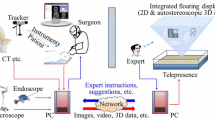Abstract
Purpose
Many stereoscopic displays require glasses that are awkward or inappropriate for use in a neurosurgical operating room. A glass-free three-dimensional autostereoscopic display (3DAD) monitor was developed and tested for neurosurgical applications.
Methods
Our 3DAD system uses images acquired from nine directions projected into the viewer’s eyes through 1,280 lenticular lenses (\(\text {1,280} \times 720\) pixels). The viewer interprets these as a single stereoscopic image. To evaluate the 3D visualization capabilities of the 3DAD system, 3D images of blood vessels created from brain magnetic resonance angiography were presented to 20 neurosurgeons on both a standard medical two-dimensional (2D) monitor and our 3DAD monitor. Discrimination of the positional relationships for each vessel was recorded. The observers were asked to identify blood vessels located in front of three pairs of points on each image.
Results
The neurosurgeon observers achieved significantly higher correct responses using the 3DAD monitor compared with the 2D monitor (91.7 vs. 56.7 %, \(p<0.0001\)). There were no reports of problems such as eye fatigue or discomfort.
Conclusion
Displaying 3D volume rendered multimodality images with a 3DAD monitor is useful for anatomical discrimination of 3D vessels in MR angiography. This technology may be useful for a wide variety of clinical applications such as rapid and precise diagnosis, surgical simulation, and medical education.





Similar content being viewed by others
References
Wade NJ (2012) Wheatstone and the origins of moving stereoscopic images. Perception 41(8):901–924
Banks MS, Read JC, Allison RS, Watt SJ (2012) Stereoscopy and the human visual system. SMPTE Motion Imaging J 121(4):24–43. doi:10.5594/j18173
Jinnin M, Fukushima S, Masuguchi S, Tanaka H, Kawashita Y, Ishihara T, Ihn H (2011) Evaluation of usefulness of 3D views for clinical photography. Biosci Trends 5(5):211–216
Abildgaard A, Witwit AK, Karlsen JS, Jacobsen EA, Tennoe B, Ringstad G, Due-Tonnessen P (2010) An autostereoscopic 3D display can improve visualization of 3D models from intracranial MR angiography. Int J Comput Assist Radiol Surg 5(5):549–554. doi:10.1007/s11548-010-0509-5
Liao H, Dohi T, Nomura K (2010) Autostereoscopic 3D display with long visualization depth using referential viewing area based integral photography. IEEE Trans Vis Comput Graph. doi:10.1109/TVCG.2010.267
Fukushima R, Taira K, Saishu T, Hirayama Y (2004) Novel viewing zone control method for computer-generated integral 3-D imaging. Proc SPIE 5291:81–92
Hirayama Y (2008) One-dimensional integral imaging 3D display systems. Proc 3rd Int Univers Commun Symp 6803: 141–145
Lippmann MG (1908) Epreuves reversibles. Photographies integrales. Comptes Rendus de l’Academie des Sciences 146:446–451
Nagatani H, Hirayama Y (2008) Evaluation of the influence on the human body of the autostereoscopic display based on the integral imaging method. Proc SPIE 6803:68030E.68031–68030E.68038
Chan S, Conti F, Salisbury K, Blevins NH (2013) Virtual reality simulation in neurosurgery: technologies and evolution. Neurosurgery 72(Suppl 1):A154–164. doi:10.1227/NEU.0b013e3182750d26
Ferroli P, Tringali G, Acerbi F, Schiariti M, Broggi M, Aquino D, Broggi G (2013) Advanced 3-dimensional planning in neurosurgery. Neurosurgery 72(Suppl 1):A54–62. doi:10.1227/NEU.0b013e3182748ee8
Malone HR, Syed ON, Downes MS, D’Ambrosio AL, Quest DO, Kaiser MG (2010) Simulation in neurosurgery: a review of computer-based simulation environments and their surgical applications. Neurosurgery 67(4):1105–1116. doi:10.1227/NEU.0b013e3181ee46d0
Meglan D, Champion HR (2011) Neurosurgery simulation. Neurosurgery 68(5):E1508; author reply E1508–1509. doi:10.1227/NEU.0b013e318210f038
Mitha AP, Almekhlafi MA, Janjua MJ, Albuquerque FC, McDougall CG (2013) Simulation and augmented reality in endovascular neurosurgery: lessons from aviation. Neurosurgery 72(Suppl 1):A107–114. doi:10.1227/NEU.0b013e31827981fd
Acknowledgments
This study was supported by the National Cancer Center Research and Development Fund no. 23-A-49.
Conflict of interest
The all authors (Yoshitaka Narita1, Shinsuke Tsukagoshi, Masahiro Suzuki, Yasuji Miyakita, Makoto Ohno, Hideyuki Arita, Yasuo Saito, Yoshiyuki Kokojima, Naofumi Watanabe, Noriyuki Moriyama, Soichiro Shibui) declare no conflict of interest.
Author information
Authors and Affiliations
Corresponding author
Rights and permissions
About this article
Cite this article
Narita, Y., Tsukagoshi, S., Suzuki, M. et al. Usefulness of a glass-free medical three-dimensional autostereoscopic display in neurosurgery. Int J CARS 9, 905–911 (2014). https://doi.org/10.1007/s11548-014-0984-1
Received:
Accepted:
Published:
Issue Date:
DOI: https://doi.org/10.1007/s11548-014-0984-1




